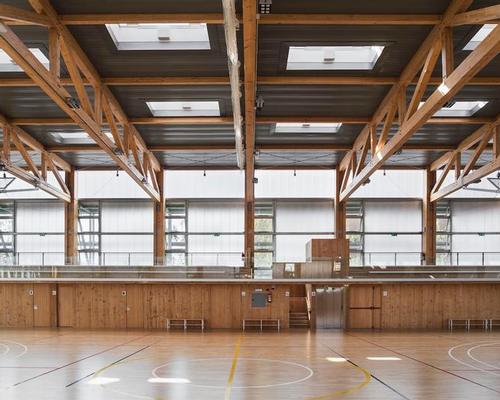05 Feb 2020
Sustainable sports centre in Barcelona features greenery, timber and passive design
BY Stu Robarts

A sports centre in Barcelona, designed by Anna Noguera and Javier Fernandez, has won awards for its sustainable and innovative design, which includes a greenery-covered façade, swathes of glazing and timber interiors.
Barcelona City Council appointed Noguera and Fernandez after they won an architectural competition it ran in 2014.
The competition briefed for the creation of a sports centre in the Turó de la Peira area of Barcelona, in which there is a high density of buildings and a lack of green areas and public facilities.
The winning proposal was chosen for its integration of a single large building into the site, its commitment to sustainability and its respect for the environment.
Completed in mid-2019, CEM Turó de la Peira recently won the Ciutat de Barcelona Award for Architecture & Urbanism and the Mapei Awards for Sustainable Architecture, as well as having been shortlisted at the World Architecture Festival.
The centre was built in unused space between two neighbouring buildings within an urban landscape of hard pavement, concrete walls and total absence of vegetation.
Covering 4,430sq m (47,680sq ft), it houses a swimming pool on the ground floor and a sports court on its upper floor, while outside there is a garden used to support biodiversity in the area.
The body of the structure is made from prefabricated laminated wood for its excellent lifecycle characteristics, mechanical performance and its lightness, which meant cost savings for foundational works and a construction time of only eight weeks.
The resulting abundance of wood inside the building creates a natural, warm atmosphere that contrasts to the often cold and functional feel of such facilities.
In addition, it is filled with natural light through larges expanses of glazing and translucent panelling, adding to the sense of naturality and helping to minimise the need to use artificial lighting.
The envelope of the building is wrapped in a scaffolding-like façade covered in greenery that is grown by a hydroponic planting system. This shields the building from the sun, creates a bioclimatic space and introduces additional biodiversity to the local area, with flowering that changes throughout the year.
Passive design also contributes to the building's sustainability, with its volume embedded into the ground to minimise thermal losses, ventilation provided by 24 sensor-controlled skylights and lateral windows and thermal insulation based on solar orientation.
Photovoltaic panels on the roof generate 95.534 kWh of energy per year, an aerothermal system recovers heat for the production of hot water and rainwater is collected for use irrigating the façade.
Close Window